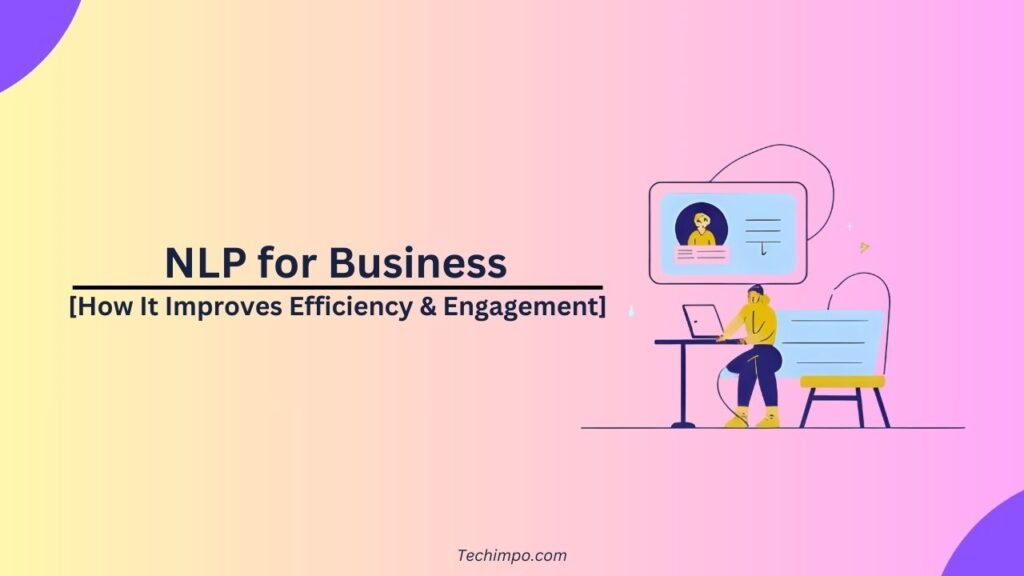Every business interaction, from emails and reports to customer chats and social media, revolves around language, which is why many businesses deal with enormous volumes of text every day. Natural language processing (NLP) is used to interpret this information, which is now required.
NLP is gaining popularity because it makes business operations more efficient. It fills the gap between machine comprehension and human language as businesses are increasingly utilizing it to automate repetitive tasks and obtain insights more quickly. They also seek to establish deeper connections with clients.
The digital transformation is happening at a faster rate. New technologies are quickly tried by rivals. Consumers anticipate more individualized and expedited experiences. Companies that put off implementing NLP tools will lag behind. Those who take action now will have an advantage.
What Is NLP (and Why It Matters)
A branch of artificial intelligence that focuses on human language is called natural language processing, or NLP. It enables machines to read and comprehend speech or text in a natural-feeling manner. Then, it reacts to that in creative ways.
For company executives, this means that technology can now automatically interpret documents, conversations, and customer feedback.
Traditional analytics tools are not the same as natural language processing. Numbers, tables, and codes are examples of structured data that most analytics work well with. Dashboards and business reports are based on that kind of information.
However, not all business data is organized neatly into rows and columns. This data is frequently overlooked or oversimplified by traditional systems. NLP is designed to unlock it.
NLP adds another level of business value by working with unstructured data. It can reveal market trends concealed in colloquial language, detect compliance risks, and gauge customer sentiment. Decision-makers gain deeper insights from this than just numbers.
The significance is obvious to executives. Businesses can automate routine communication, decrease manual labour, and respond to customer needs more quickly with NLP.
Replacing people is not the goal. It’s about providing teams with improved tools to comprehend and react to the ever-changing stream of information. NLP keeps companies alert and responsive in a market where relevance and speed determine success.
How NLP Drives Business Efficiency

– Automating Manual and Repetitive Tasks
Employees still perform basic, repetitive tasks in many business processes. These chores take time and divert attention from important work. NLP assists by taking over repetitive tasks. They include processing forms and sorting documents.
In terms of customer support, they include responding to consumer inquiries. This translates into reduced expenses and fewer mistakes with quicker results.
- Chatbots provide prompt answers to consumer questions.
- Workflow automation expedites repetitive procedures.
- Document classification groups files into the appropriate categories.
– Internal Communication and Knowledge Access
Too much data is dispersed throughout several systems in large organisations. Workers squander time looking for files or requesting assistance. NLP tools provide instantaneous text translation, document summarisation, and intelligent search systems. Teams can work across borders, find answers more easily, and learn more quickly as a result.
- The appropriate information is presented by intelligent search engines.
- Auto-summarization provides brief highlights of lengthy texts.
- Language translation facilitates international collaboration.
– Data-Driven Decision Making
To make the best choices, company executives require insights. Unstructured text typically conceals a lot of that information. For example, emails or posts on social media. This data can be scanned by NLP to identify important trends or hazards.
This aids businesses in better planning, quicker customer service, and rule compliance.
- Insights from emails, reports, and support tickets.
- Trend forecasting highlights upcoming market shifts.
- Compliance monitoring flags potential risks early.
How NLP Boosts Engagement
– Customer Service and Personalization
Artificial intelligence services significantly change customer experience. Consumers anticipate prompt, individualised assistance. NLP tools enable businesses to hear the tone of their customers, comprehend their intent, and respond in a useful manner.
While sending complex problems to the appropriate team, bots can provide instant answers to simple questions. Stronger loyalty is developed, and the experience is made more seamless.
- Sentiment analysis adjusts responses to customer mood.
- Intelligent routing directs issues to the right team.
- Proactive outreach responds to feedback before problems grow.
– Marketing and Sales Interactions
When marketing speaks to the needs of each individual customer, it seems more successful. By examining consumer behaviour, preferences, and responses, NLP enables this.
Teams can use it to develop customised campaigns, suggest relevant content, and interact with prospects at the ideal moment. Stronger relationships and increased conversions are the results of this.
- Automated content recommendations match customer interests.
- Campaign tailoring adapts based on customer sentiment.
- Segmentation and lead scoring guides targeted follow-ups.
– Multilingual and Inclusive Support
Businesses now cater to clients in a variety of languages and geographical areas. Real-time translation and accessible communication are two ways that NLP tools facilitate barrier-breaking.
This implies that businesses can be more inclusive, reach a larger audience, and foster trust among a variety of groups.
- Real-time translation removes language barriers.
- Accessibility features support inclusive communication.
- Multilingual support expands market reach.
Common NLP Challenges
Businesses may face difficulties when implementing NLP. Because customer data needs to be handled carefully, data privacy is a major concern. Since new tools need to work with existing systems, integration presents additional challenges.
Additionally, some businesses begin with irrational expectations. Projects may also be slowed down by expenses, a lack of skilled workers, and the requirement for clean data.
- Protecting sensitive customer data is critical.
- Integrating NLP tools with legacy systems is complex.
- Teams may expect instant results without preparation.
- High-quality data is required for accurate outcomes.
- Hiring skilled talent can be difficult.
Best Practices
Well-planned businesses can steer clear of the majority of these issues. Small projects with immediate results are the first step. Teams ought to be adaptable and change course as necessary. Accurate systems are maintained through ongoing training and feedback.
In order to maintain equity and trust, human oversight is also crucial. By using these techniques, businesses can truly benefit from NLP.
- Start with pilot projects that have clear goals.
- Adopt an agile approach and improve step by step.
- Provide ongoing training for employees and systems.
- Keep humans in the loop for sensitive decisions.
- Monitor outcomes regularly and refine models.
What’s Next for NLP?
What does NLP have ahead of it? Businesses need to stay ahead of the curve because the field is changing quickly. The following trends are worth keeping an eye on:
- Multimodal AI: systems that integrate audio, video, images, and text to provide a more profound understanding.
- Voice-driven interfaces, which use natural voice conversations to improve customer experiences.
- Context-aware personalization: more intelligent tools that comprehend the meaning and context of words.
Why does this matter?
Due to shifting consumer expectations. Instant responses, organic dialogues, and services that seem to be customised to their needs are what people desire.
How should businesses respond?
By being flexible. Flexibility is essential as technology continues to advance. Leaders can take these easy steps:
- Pay attention to new tools and platforms.
- Use tiny pilots to test new features.
- Motivate groups to keep learning.
- Combine machine intelligence and human judgment.
- When the needs of your customers change, be ready to adapt.
The takeaway is unambiguous: NLP is dynamic. Businesses that keep learning, testing, and adapting will remain competitive.
Summary
NLP is not a concept of the future. It has arrived and is already altering how companies operate. It also helps businesses engage with their customers.
They use it to find insights in common language and automate repetitive tasks. Its important role is to provide faster service to consumers. They benefit from more individualised experiences and improved support.
The path ahead is straightforward. It is important for you to learn quickly. Partner with an AI development company and start small. Then, eventually, scale as soon as you see results. You should also keep people informed to maintain fairness and trust.
Here are some quick things to consider:
- How NLP can help my team save time today
- How I can provide better customer service
- Which project I can start with NLP
If you have a clear understanding of this, then the time to act is now. Businesses that act quickly will reap the rewards sooner.




